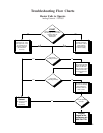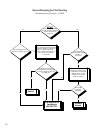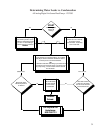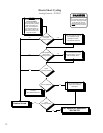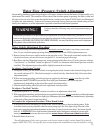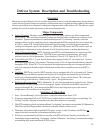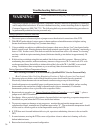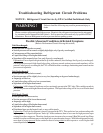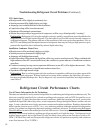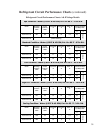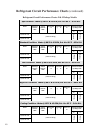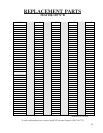
38
Troubleshooting Refrigerant Circuit Problems (Continued)
Use of Charts- Information for the Technician:
The charts are intended for use by trained and qualified air-conditioning and refrigeration technicians only. The
charts are compiled specifically for evaluation and diagnostic purposes, and are NOT designed for use as
charging charts. To apply the chart data to actual conditions: gather the operating pressures, suction tube
superheat & liquid line subcooling values, water temperature change through the heater, and the total unit
amps. Locate a chart that most closely represents current actual ambient conditions. Readings obtained that
differ from the charts in excess of 10% (+ or -), may indicate a problem within the mechanical refrigeration
system. For guidance in diagnosing abnormal operating conditions, reference: Troubleshooting Refrigerant
Circuit Problems, located in this manual just forward of this section. Some interpolation between charts will be
necessary, should actual ambient conditions not align reasonably well with the charts. If refrigerant circuit
readings appear normal, but not the Water ∆T value, the likely cause will be water flow above or below 45-
GPM. (All Heat Wave and AeroTemp model refrigerant circuits will perform acceptably with condenser
water flow between 20-to-70 GPM.)
Refrigerant Circuit Performance Charts
TXV Stuck Open:
• Head pressure will be slightly to moderately low;
• Suction pressure will be slightly high to very high;
• Amperage (not a reliable indicator of this condition);
• Liquid subcooling will be lower than normal;
• Superheat will be minimal or nonexistent;
• Suction line, and possibly a large portion of compressor, will be very cold and possibly “sweating”.
Explanation: Refrigerant is flowing through the system too quickly; enough heat cannot be added in the
evaporator to boil off all the liquid refrigerant. The main effect is to flood the suction line and compressor
with liquid refrigerant. The primary indicator of this condition is little or no suction line superheat. Also, as
the TXV is not holding back the required amount of refrigerant, there may be flash gas (high-pressure vapor)
present in the liquid line; this is indicated by reduced liquid subcooling.
Insufficient Condenser Water Flow:
• Head pressure will be moderately high to very high;
• Suction pressure my be normal to slightly high;
• Amperage will be higher than normal;
• Liquid subcooling will be absent; the liquid line will be very warm or even hot to touch. When combined with
high condenser water ∆T (see next bullet item), this condition is a prime indicator of insufficient condenser
water flow;
• Condenser entering-leaving water temperature difference (water ∆T) will be higher than normal… This
condition, is a prime indicator of insufficient condenser water flow;
• Superheat will be high-normal to high.
Explanation: Heat is not being removed in the condenser in quantities sufficient to produce appreciable
amounts of liquid refrigerant. With no liquid seal occurring in the condenser, the liquid line–in essence–
becomes an extended discharge line. Keys to diagnosis: very warm to hot liquid line, and a high condenser
water Delta-T.



